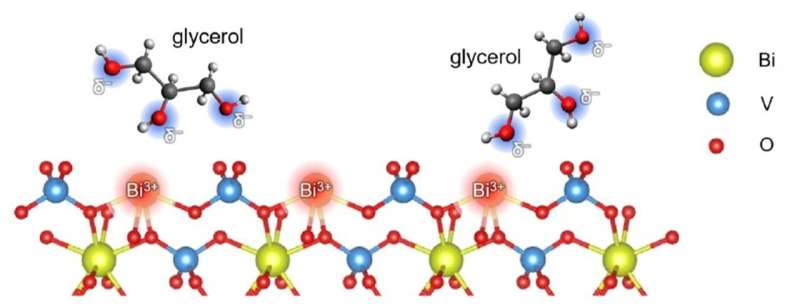This article has been reviewed according to Science X's editorial process and policies. Editors have highlighted the following attributes while ensuring the content's credibility:
fact-checked
peer-reviewed publication
trusted source
proofread
From waste to value: The right electrolytes can enhance glycerol oxidation

In 2023, around 16 billion liters of biodiesel and HVO diesel were produced in the European Union, based on maize, rapeseed, or partially on waste materials from agricultural production. A by-product of biodiesel production is glycerol, which can be used as a building block for the production of valuable chemicals such as dihydroxyacetone, formic acid, glyceraldehyde and glycolaldehyde via a glycerol oxidation reaction (GOR). Glycerol can be oxidized electrochemically in (photo)electrochemical (PEC) reactors, which are currently being developed specifically for the production of green hydrogen.
However, this path in PEC-plants is still hardly exploited at present, even though it could significantly increase the economic efficiency of the PEC Power-to-X process, since the oxidation of glycerol requires a much lesser energy input than hydrogen production through water splitting, but at the same time produces more valuable chemicals.
Examining the influence of different electrolytes
Many studies have already investigated the role of photocatalysts in PEC electrolyzers, while the role of the electrolyte had not yet been systematically analyzed. A team led by Dr. Marco Favaro at the Institute for Solar Fuels has now unveiled the influence of electrolyte composition on the efficiency and stability of glycerol oxidation.
The team's paper is published in the journal Chemical Science.
They used a PEC cell with photoanodes made of nanoporous bismuth vanadate (BiVO4). They tested acidic electrolytes (pH = 2) with various cations and anions, including sodium nitrate (NaNO3), sodium perchlorate (NaClO4), sodium sulfate (Na2SO4), potassium sulfate (K2SO4) and potassium phosphate (KPi).
"Our results showed that BiVO4 photoanodes perform best in NaNO3 and outperform the commonly used Na2SO4 in terms of photocurrent, stability, and production rates of high-quality glycerol oxidation reaction products," summarizes Favaro.
Sodium nitrate performs best
The team also investigated the reasons for this difference in performance. Their hypothesis is that the size of the ions, their different salting in/out capabilities (Hofmeister series), and their different pH buffering capacity play a role.
"The composition of the electrolyte has a surprising clear effect on the glycerol oxidation efficiency, and we were able to observe this trend in both bismuth vanadate and polycrystalline platinum anodes," says Ph.D. student Heejung Kong. This supports the assumption that these findings could generally apply to different materials and processes.
The choice of electrolyte is therefore of great importance for the efficiency and stability of glycerol oxidation.
"Our research could help to convert biomass by-products into valuable chemicals more efficiently and to produce valuable chemicals from waste materials while minimizing the impact on the environment," says Favaro.
More information: Heejung Kong et al, Electrolyte selection toward efficient photoelectrochemical glycerol oxidation on BiVO4, Chemical Science (2024). DOI: 10.1039/D4SC01651C
Journal information: Chemical Science
Provided by Helmholtz Association of German Research Centres



















